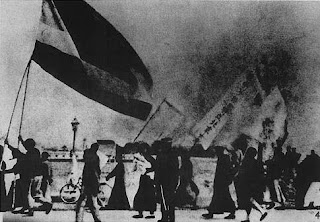The Long Marches of Different People
 |
| The Chinese Revolution (from Wikimedia Commons) |
As in the multiplicity of those historical marches in the world’s largest country last century, there have been apparently a huge number of our pursuits to bring about a fundamental change in the segregated worlds across the globe. Alternatively, it represents the various struggles across the world.
While we are sitting here, hundreds of thousands of insurgents are roaming across the Southeast Asian jungles, suburbs and a lucky few in the towns and cities. An equal number of common people are out on the streets of Egypt and Brazil. Another thousand of Maoists are stirring up the official Indian largest security threat in the eastern and central part of the subcontinent. Some of these, we can easily name here, and there are many, many more struggles for peace and prosperity—though the means, the perceptions, the opinions and the experiences would be totally relative.
Some call them social revolution, mass awakening and others, the sedition, dissent, armed struggle, or in the case of my native place, a misguided and an untoward law and order problem. The range of terms only shows the complexities that we have to deal separately for the sake of clarity.
 |
| From the World Wide Freedom |
The Chinese Long March has a set of historical contexts that form the present China. With this understanding, at the most superficial level on a larger scale, we can see that each country and region of the globe has its own predicaments, resorting to long marches of hope. And each one of us is trying to overcome them in customised marches, no matter how long or short those are.
All of these boil down to the chaos that marks our existence on one hand. This prompts the people, on the other, to take the matter in their own hands. It is not necessary that we have to use violence for our goals, despite the historical narratives of using violence as a means of one’s political goals. It does not either imply, we have to live up to the status quo. The priority, as in to realise our dreams, is just to wake up.
In Anarchism and Other Essays, Emma Goldman wrote about the psychology of political violence. She penned, ‘To analyze the psychology (of political violence) is not only extremely difficult, but also very dangerous.
 |
| From the World Wide Freedom |
‘If such acts are treated with understanding, one is immediately accused of eulogizing them.’
She added, ‘If, on the other hand, human sympathy is expressed, one risks being considered a possible accomplice. Yet it is only intelligence and sympathy that can bring us closer to the source of human suffering, and teach us the ultimate way out of it.’
Yet, this is not the reason to detest violence. Our entire generation, in my native place, grew up in a noisy and messy environment, where the power is concentrated in the barrels of the guns. The game is still on. On many occasions, the multiple movements of the anti-establishment and approaches of the establishment are signaling the need for heralding a new approach to find a lasting solution. As regards to long marches, there are varying marches for the right to self-determination, movements for social revolution, and restoring the deviated identity and so on.
With a clear-cut approach of the long march, there is no reason why the marches would fail to deliver the goods. It is different though, what we wish for, and what we get. With all the naivety, it is still nice to imagine a world where ‘all the people live for today’, ‘all the people live life in peace’ and ‘all the people share all the world.’
.....................................................................................................................
 |
| Image: Source |
★ The Long March is a manifesto. It has proclaimed to the world that the Red Army is an army of heroes while the imperialists and their running dogs, Chiang Kai-shek and his like, are impotent. It has proclaimed their utter failure to encircle, pursue, obstruct and intercept us. The Long March is also a propaganda force. It has announced to some 200 million people in 11 provinces that the road of the Red Army is their only road to liberation. Without the Long March, how could the broad masses have learned so quickly about the existence of the great truth which the Red Army embodies? The Long March is also a seeding-machine. In the eleven provinces it has sown many seeds which will sprout, leaf, blossom, and bear fruit, and will yield a harvest in the future. In a word, the Long March has ended with victory for us and defeat for the enemy. —Mao Tse-tung
.....................................................................................................................
Additional note:
“...the Westphalian system had its limits. For one, the principle of sovereignty it relied on also produced the basis for rivalry, not community of states; exclusion, not integration. Further, the idea of a strong, sovereign state was later draped with nationalistic fervour that degenerated into a destructive political force. The stability of this system could only be maintained by constantly shifting alliances, cordial and not-so-cordial ententes, and secret agreements.”
— Securing Peace in Europe, by Dr. Javier Solana, Secretary General of NATO
.....................................................................................................................

Comments
Post a Comment